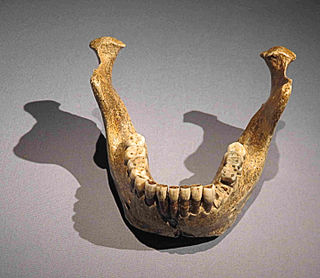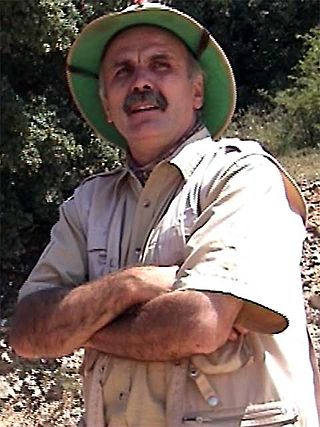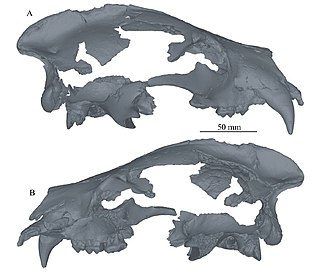
The brown bear is a large bear species found across Eurasia and North America. In North America, the populations of brown bears are called grizzly bears, while the subspecies that inhabits the Kodiak Islands of Alaska is known as the Kodiak bear. It is one of the largest living terrestrial members of the order Carnivora, rivaled in size only by its closest relative, the polar bear, which is much less variable in size and slightly bigger on average. The brown bear's range includes parts of Russia, Central Asia, the Himalayas, China, Canada, the United States, Hokkaido, Scandinavia, Finland, the Balkans, the Picos de Europa and the Carpathian region, Iran, Anatolia, and the Caucasus. The brown bear is recognized as a national and state animal in several European countries.

The cave bear is a prehistoric species of bear that lived in Europe and Asia during the Pleistocene and became extinct about 24,000 years ago during the Last Glacial Maximum.

Ursinae is a subfamily of Ursidae (bears) named by Swainson (1835). It was assigned to Ursidae by Bjork (1970), Hunt (1998), and Jin et al. (2007).

Ursus is a genus in the family Ursidae (bears) that includes the widely distributed brown bear, the polar bear, the American black bear, and the Asian black bear. The name is derived from the Latin ursus, meaning bear.

Homo heidelbergensis is an extinct species or subspecies of archaic human which existed during the Middle Pleistocene. It was subsumed as a subspecies of H. erectus in 1950 as H. e. heidelbergensis, but towards the end of the century, it was more widely classified as its own species. It is debated whether or not to constrain H. heidelbergensis to only Europe or to also include African and Asian specimens, and this is further confounded by the type specimen being a jawbone, because jawbones feature few diagnostic traits and are generally missing among Middle Pleistocene specimens. Thus, it is debated if some of these specimens could be split off into their own species or a subspecies of H. erectus. Because the classification is so disputed, the Middle Pleistocene is often called the "muddle in the middle".

Homo antecessor is an extinct species of archaic human recorded in the Spanish Sierra de Atapuerca, a productive archaeological site, from 1.2 to 0.8 million years ago during the Early Pleistocene. Populations of this species may have been present elsewhere in Western Europe, and were among the first to colonise that region of the world, hence the name. The first fossils were found in the Gran Dolina cave in 1994, and the species was formally described in 1997 as the last common ancestor of modern humans and Neanderthals, supplanting the more conventional H. heidelbergensis in this position. H. antecessor has since been reinterpreted as an offshoot from the modern human line, although probably one branching off just before the modern human/Neanderthal split.
The Atapuerca Mountains is a karstic hill formation near the village of Atapuerca in the province of Burgos, northern Spain.

The Tremarctinae or short-faced bears is a subfamily of Ursidae that contains one living representative, the spectacled bear of South America, and several extinct species from four genera: the Florida spectacled bear, the North American giant short-faced bears Arctodus, the South American giant short-faced bear Arctotherium as well as Plionarctos(P. edensis and P. harroldorum), which is thought to be ancestral to the other three genera. Of these, the giant short-faced bears may have been the largest ever carnivorans in the Americas. The group is thought to have originated in eastern North America, and then invaded South America as part of the Great American Interchange. Most short-faced bears became extinct at the end of the Pleistocene.

Eudald Carbonell i Roura is a Spanish archaeologist, anthropologist and paleontologist.

Ursus deningeri is an extinct species of bear, endemic to Eurasia during the Pleistocene for approximately 1.7 million years, from 1.8 to 0.1 million years ago.

Ursus etruscus is an extinct species of bear, endemic to Europe, Asia and North Africa during the Pliocene through Pleistocene, living from ~5.3 million to 100,000 years ago.

Triaenops goodmani is an extinct bat from Madagascar in the genus Triaenops. It is known from three lower jaws collected in a cave at Anjohibe in 1996, and described as a new species in 2007. The material is at most 10,000 years old. A bat humerus from the same site could not be identified as either T. goodmani or the living T. menamena. T. goodmani is identifiable as a member of Triaenops or the related genus Paratriaenops by a number of features of the teeth, such as the single-cusped, canine-like fourth premolar and the presence of a gap between the entoconid and hypoconulid cusps on the first two molars. T. goodmani is larger than the living species of Triaenops and Paratriaenops on Madagascar, and on the first molar the protoconid cusp is only slightly higher than the hypoconid, not much higher as in the other species.

Tautavel Man refers to the archaic humans which—from approximately 550,000 to 400,000 years ago—inhabited the Caune de l’Arago, a limestone cave in Tautavel, France. They are generally grouped as part of a long and highly variable lineage of transitional morphs which inhabited the Middle Pleistocene of Europe, and would eventually evolve into the Neanderthals. They have been variably assigned to either H. (s.?) heidelbergensis, or as a European subspecies of H. erectus as H. e. tautavelensis. The skull is reconstructed based on the specimens Arago 21 and 47, and it is, to a degree, more characteristic of what might be considered a typical H. erectus morphology than a typical H. heidelbergensis morphology. The brain capacity is 1,166 cc. They seem to have had an overall robust skeleton. Average height may have been 166 cm.

Ursus rossicus is an extinct species of bear that lived in the steppe regions of northern Eurasia and Siberia during the Pleistocene.
Ursus ingressus is an extinct species of the family Ursidae that lived in Central Europe during the Late Pleistocene. It is named after the Gamssulzen Cave in Austria, where the holotype of this species was found.

The archaeological site of Atapuerca is located in the province of Burgos in the north of Spain and is notable for its evidence of early human occupation. Bone fragments from around 800,000 years ago, found in its Gran Dolina cavern, provide the oldest known evidence of hominid settlement in Western Europe and of hominid cannibalism anywhere in the world.

Protarctos is an extinct genus of basal ursine bear that lived in North America and Eurasia during the Pliocene and into Early Pleistocene.
Aurorarctos is an extinct North American genus of bears. It contains a single species, Aurorarctos tirawa, which lived in the Middle Miocene. Its fossils were discovered in the Valentine formation and Myers Farm of Nebraska, and represent the earliest known member of the Ursinae, showcasing that basal members of this subfamily were small, but already showed adaptions towards increasing herbivory as well as an arboreal lifestyle The genus name combines the Latin words aurora (dawn) and Greek arctos (bear); the specific epithet references the creator god Tirawa in Pawnee mythology.

Lonchocyon is an extinct genus of arctoid carnivorans, with possible affinities to amphicyonids or hemicyonine bears. It contains a single species, Lonchocyon qiui, known from a single left mandible discovered at the fossil-bearing locality Haerhada at the base of the Baron Sog Formation, which is located in Inner Mongolia, China, and dates to the late Eocene. This taxon is notable for its large size in comparison to other arctoid carnivorans of the Eocene epoch, and for its hypercarnivorous adaptions, most notably its large canine and strongly reduced premolars. The genus name is a combination of Greek lonch, meaning spear and referencing the spear-like paraconid on its lower carnassial, and cyon, meaning dog. The specific name honours Professor Zhan-Xiang Qiu.
















